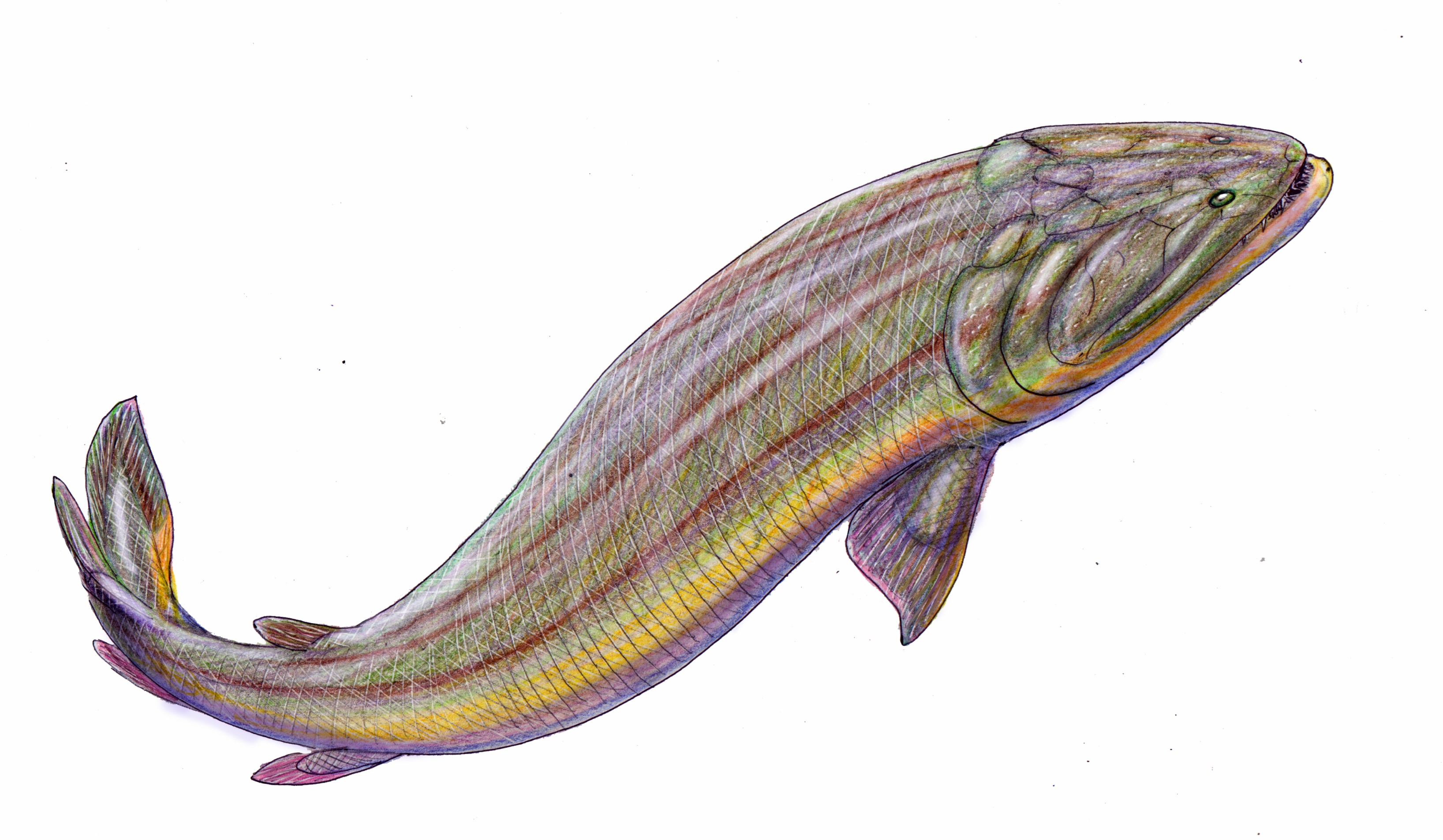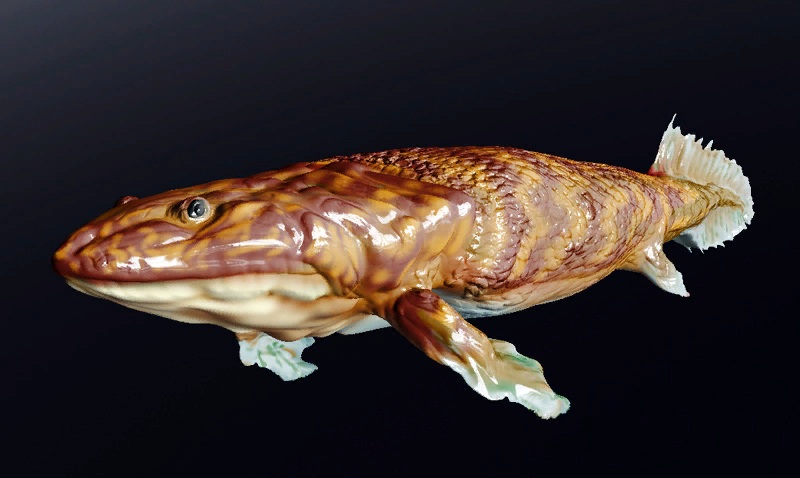|
Tetrapodomorphs
Tetrapodomorpha (also known as Choanata) is a clade of vertebrates consisting of tetrapods (four-limbed vertebrates) and their closest sarcopterygian relatives that are more closely related to living tetrapods than to living lungfish. Advanced forms transitional between fish and the early labyrinthodonts, such as ''Tiktaalik'', have been referred to as "fishapods" by their discoverers, being half-fish, half-tetrapods, in appearance and limb morphology. The Tetrapodomorpha contains the crown group tetrapods (the last common ancestor of living tetrapods and all of its descendants) and several groups of early stem tetrapods, which includes several groups of related lobe-finned fishes, collectively known as the osteolepiforms. The Tetrapodomorpha minus the crown group Tetrapoda are the stem Tetrapoda, a paraphyletic unit encompassing the fish to tetrapod transition. Characteristics Among the characteristics defining tetrapodomorphs are modifications to the fins, notably a humerus wi ... [...More Info...] [...Related Items...] OR: [Wikipedia] [Google] [Baidu] |
Tristichopteridae
Tristichopterids (Tristichopteridae) were a diverse and successful group of fish-like tetrapodomorphs living throughout the Middle and Late Devonian. They first appeared in the Eifelian stage of the Middle Devonian. Within the group sizes ranged from a few tens of centimeters (''Tristichopterus'') to several meters (''Hyneria'' and ''Eusthenodon''). Some tristichopterids share some of the features of the elpistostegalians, a diverse clade of tetrapodomorphs close to the origin of (and including) tetrapods. This mainly concerns the shape of the skull and a reduction in size of the posterior fins. An old and persistent notion is that ''Eusthenopteron'' was able to crawl onto land using its fins. However, there is no evidence actually supporting this idea.M. Laurin, F. J. Meunier, D. Germain, and M. Lemoine 2007A microanatomical and histological study of the paired fin skeleton of the Devonian sarcopterygian ''Eusthenopteron foordi'' ''Journal of Paleontology'' 81: 143–153. All t ... [...More Info...] [...Related Items...] OR: [Wikipedia] [Google] [Baidu] |
Lobe-finned Fish
Sarcopterygii (; )—sometimes considered synonymous with Crossopterygii ()—is a clade (traditionally a class or subclass) of vertebrate animals which includes a group of bony fish commonly referred to as lobe-finned fish. These vertebrates are characterised by prominent muscular limb buds (lobes) within their fins, which are supported by articulated appendicular skeletons. This is in contrast to the other clade of bony fish, the Actinopterygii, which have only skin-covered bony spines supporting the fins. The tetrapods, a mostly terrestrial clade of vertebrates, are now recognized as having evolved from sarcopterygian ancestors and are most closely related to lungfishes. Their paired pectoral and pelvic fins evolved into limbs, and their foregut diverticulum eventually evolved into air-breathing lungs. Cladistically, this would make the tetrapods a subgroup within Sarcopterygii and thus sarcopterygians themselves. As a result, the phrase "lobe-finned fish" normally refe ... [...More Info...] [...Related Items...] OR: [Wikipedia] [Google] [Baidu] |
Kenichthys
''Kenichthys'' is a genus of sarcopterygian fish from the Devonian period, and a member of the clade Tetrapodomorpha. The only known species of the genus is ''Kenichthys campbelli'' (named for the Australian palaeontologist Ken Campbell), the first remains of which were found in China in 1993.Chang, M. and Zhu, M. (1993) A new Middle Devonian osteolepidid from Qujing, Yunnan. ''Mem. Assoc. Australas. Palaeontol.'' 15 183-198 The genus is important to the study of the evolution of tetrapods due to the unique nature of its nostrils, which provide vital evidence regarding the evolutionary transition of fish-like nostrils to the tetrapod choanae.Zhu, M. and Ahlberg, P. (2004) The origin of the internal nostril of tetrapods. ''Nature'' 432 94-97 Description ''Kenichthys'' was a small tetrapodomorph, with a skull about long. While only areas of the front of the body are known, it seems likely that ''Kenichthys'' would have been similar in general body form to other basal sarcopte ... [...More Info...] [...Related Items...] OR: [Wikipedia] [Google] [Baidu] |
Tiktaalik
''Tiktaalik'' (; ) is a monospecific genus of extinct sarcopterygian (lobe-finned fish) from the Late Devonian Period, about 375 Mya (million years ago), having many features akin to those of tetrapods (four-legged animals). ''Tiktaalik'' is estimated to have had a total length of on the basis of various specimens. Unearthed in Arctic Canada, ''Tiktaalik'' is a non-tetrapod member of Osteichthyes (bony fish), complete with scales and gills—but it has a triangular, flattened head and unusual, cleaver-shaped fins. Its fins have thin ray bones for paddling like most fish, but they also have sturdy interior bones that would have allowed ''Tiktaalik'' to prop itself up in shallow water and use its limbs for support as most four-legged animals do. Those fins and other mixed characteristics mark ''Tiktaalik'' as a crucial Transitional fossil, transition fossil, a link in evolution from swimming fish to four-legged vertebrates. This and similar animals might be the common ancestors of ... [...More Info...] [...Related Items...] OR: [Wikipedia] [Google] [Baidu] |
Tetrapodomorpha
Tetrapodomorpha (also known as Choanata) is a clade of vertebrates consisting of tetrapods (four-limbed vertebrates) and their closest sarcopterygian relatives that are more closely related to living tetrapods than to living lungfish. Advanced forms transitional between fish and the early labyrinthodonts, such as '' Tiktaalik'', have been referred to as "fishapods" by their discoverers, being half-fish, half-tetrapods, in appearance and limb morphology. The Tetrapodomorpha contains the crown group tetrapods (the last common ancestor of living tetrapods and all of its descendants) and several groups of early stem tetrapods, which includes several groups of related lobe-finned fishes, collectively known as the osteolepiforms. The Tetrapodomorpha minus the crown group Tetrapoda are the stem Tetrapoda, a paraphyletic unit encompassing the fish to tetrapod transition. Characteristics Among the characteristics defining tetrapodomorphs are modifications to the fins, notably a ... [...More Info...] [...Related Items...] OR: [Wikipedia] [Google] [Baidu] |
Panderichthys
''Panderichthys'' is a genus of extinction, extinct Sarcopterygii, sarcopterygian (lobe-finned fish) from the late Devonian period, about 380 Myr, Mya. ''Panderichthys'', which was recovered from Frasnian (early Late Devonian) deposits in Latvia, is represented by two species. ''P. stolbovi'' is known only from some snout fragments and an incomplete lower jaw. ''P. rhombolepis'' is known from several more complete specimens. Although it probably belongs to a sister group of the earliest tetrapods, ''Panderichthys'' exhibits a range of features transitional between Tristichopteridae, tristichopterid lobe-fin fishes (e.g., ''Eusthenopteron'') and early tetrapods. It is named after the German-Baltic paleontologist Christian Heinrich Pander. Possible tetrapod tracks dating back to before the appearance of ''Panderichthys'' in the fossil record were reported in 2010, which suggests that ''Panderichthys'' is not a direct ancestor of tetrapods, but nonetheless shows the traits that evolve ... [...More Info...] [...Related Items...] OR: [Wikipedia] [Google] [Baidu] |
Tetrapod
A tetrapod (; from Ancient Greek :wiktionary:τετρα-#Ancient Greek, τετρα- ''(tetra-)'' 'four' and :wiktionary:πούς#Ancient Greek, πούς ''(poús)'' 'foot') is any four-Limb (anatomy), limbed vertebrate animal of the clade Tetrapoda (). Tetrapods include all Neontology#Extant taxa versus extinct taxa, extant and Extinction, extinct amphibians and amniotes, with the latter in turn Evolution, evolving into two major clades, the Sauropsida, sauropsids (reptiles, including dinosaurs and therefore birds) and synapsids (extinct pelycosaur, "pelycosaurs", therapsids and all extant mammals, including Homo sapiens, humans). Hox gene mutations have resulted in some tetrapods becoming Limbless vertebrate, limbless (snakes, legless lizards, and caecilians) or two-limbed (cetaceans, sirenians, Bipedidae, some lizards, kiwi (bird), kiwis, and the extinct moa and elephant birds). Nevertheless, they still qualify as tetrapods through their ancestry, and some retain a pair of ves ... [...More Info...] [...Related Items...] OR: [Wikipedia] [Google] [Baidu] |
Choana
The choanae (: choana), posterior nasal apertures or internal nostrils are two openings found at the back of the nasal passage between the nasal cavity and the pharynx, in humans and other mammals (as well as crocodilians and most skinks). They are considered one of the most important synapomorphies of tetrapodomorphs, that allowed the passage from water to land. In animals with secondary palates, they allow breathing when the mouth is closed. Janvier, Philippe (2004) "Wandering nostrils". ''Nature'', 432 (7013): 23–24. In tetrapods without secondary palates their function relates primarily to olfaction (sense of smell). The choanae are separated in two by the vomer. Boundaries A choana is the opening between the nasal cavity and the nasopharynx. It is therefore not a structure but a space bounded as follows: * anteriorly and inferiorly by the horizontal plate of palatine bone, * superiorly and posteriorly by the sphenoid bone * laterally by the medial pterygoid pla ... [...More Info...] [...Related Items...] OR: [Wikipedia] [Google] [Baidu] |
Stegocephali
Stegocephali (often spelled Stegocephalia, from Greek , lit. "roofed head") is a clade of vertebrate animals containing all fully limbed tetrapodomorphs. It is equivalent to a broad definition of the superclass Tetrapoda: under this broad definition, the term "tetrapod" applies to any animal descended from the first vertebrate with four limbs each with digits in the extremity (pentadactyly), rather than fins of their sarcopterygian relatives. Stegocephalians include both the modern lineage of limbed vertebrates (the crown group tetrapods, including modern amphibians, reptiles, birds and mammals) as well as a portion of the stem group, the earliest limbed tetrapodomorphs such as ''Ichthyostega'' and ''Acanthostega'', which evolved in the Devonian period long before the origin of the crown group. Many paleontologists prefer a stricter definition of Tetrapoda which applies solely to the crown group, excluding earlier types of limbed tetrapodomorphs. Stegocephali was re-estab ... [...More Info...] [...Related Items...] OR: [Wikipedia] [Google] [Baidu] |
Osteolepiform
Osteolepiformes, also known as Osteolepidida, is a group of prehistoric lobe-finned fishes which first appeared during the Devonian period. The order contains the families Canowindridae, Megalichthyidae, Osteolepididae and Tristichopteridae, in addition to several monotypic families. The order is generally considered to be paraphyletic because the characters that define it are mainly attributes of stem tetrapodomorphs. The following taxonomy is based on Borgen & Nakrem, 2016: * Order Osteolepiformes ** Suborder Osteolepidoidei *** Family Osteolepididae *** Family Thursiidae *** Family Megalichthyidae ** Suborder Cyclolepidoidei *** Superfamily Eopodoidea **** Family Chrysolepididae **** Family Gyroptychiidae **** Family Panderichthyidae (incl. Elpistostegalia) **** Family Tristichopteridae *** Superfamily Parapodoidea **** Family Canowindridae **** Family Medoevididae *** Superfamily Rhizodontoidea Below is a cladogram A cladogram (from Greek language, Gre ... [...More Info...] [...Related Items...] OR: [Wikipedia] [Google] [Baidu] |







